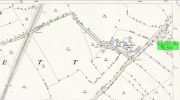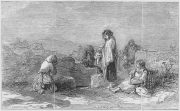Holy Well (lost): OS Grid Reference – SE 134 331 (approximation)
Archaeology & History
This site is both interesting and frustrating at the same time. Interesting inasmuch that as early as 1258 CE, “the Knights Hospitallers of St. John of Jerusalem in England, had in Allerton a manor called the manor of Crosley.” The Hospitallers, as some will know, were the immediate successors of the more famous Knights Templars. As their name suggests, their patron saint was St John, whose festival date was summer solstice and had his name given to many holy wells. But this one has left us with no name and its location has long since been lost. In J.H. Bell’s (1888) essay on the early medical history of the area he told that local people with certain afflictions, “were wont to resort to them to drink their waters for their supposed medicinal virtues: there was one between Cemetery Bridge and Crossley Hall”. But he doesn’t give its exact position. In John James’ (1841) classic History of Bradford he thinks that near the place where the local stream known as the Hebble, “there was undoubtedly in former times a Holy well,” but is unable to cite a location. No well is shown on the early maps between the old Hall and the cemetery and the only definitive reference to wells close by are in the early boundary perambulation record, which describe a Brock Well and a Cold Well. Perhaps the the most probable contender and location is cited in Harry Speight’s (aka Johnnie Gray) Pleasant Walks (1890) where, taking a route between Great Horton and Allerton, he told us to,
“go through fields on to Necropolis Road, opposite Scholemoor cemetery, turn down lane left outside cemetery, ½ mile, descending steps, cross beck (here used to be the Spa Beck public gardens, now removed higher up) and ascend, at second field, leaving the forward path and turn left, following beck with Crosley Hall and trees to right.”
The location of the said Spa Beck gardens is very close to where Mr Bell described the medicinal spring and is/was the most likely position of what James (1841) thought to be a long lost holy well. If we could get more information about the history of the Spa Well, we may be able to make more definitive statements about the place.
References:
- Bell, J.H., “Some Fragments of Local Medical History,” in Bradford Antiquary, volume 1, 1888.
- Gray, Johnnie, Where to Spend a Half-Holiday: One Hundred and Eighty Pleasant Walks around Bradford, Thomas Brear: Bradford 1890.
- James, John, History and Topography of Bradford, Charles Stanfield: Bradford 1841.
- Shepherd, Val, Historic Wells in and Around Bradford, HOAP: Wymeswold 1994.
© Paul Bennett, The Northern Antiquarian
The map could not be loaded. Please contact the site owner.








